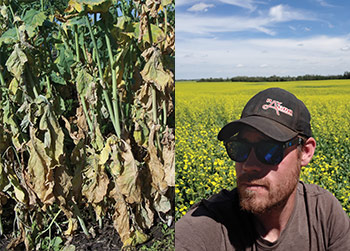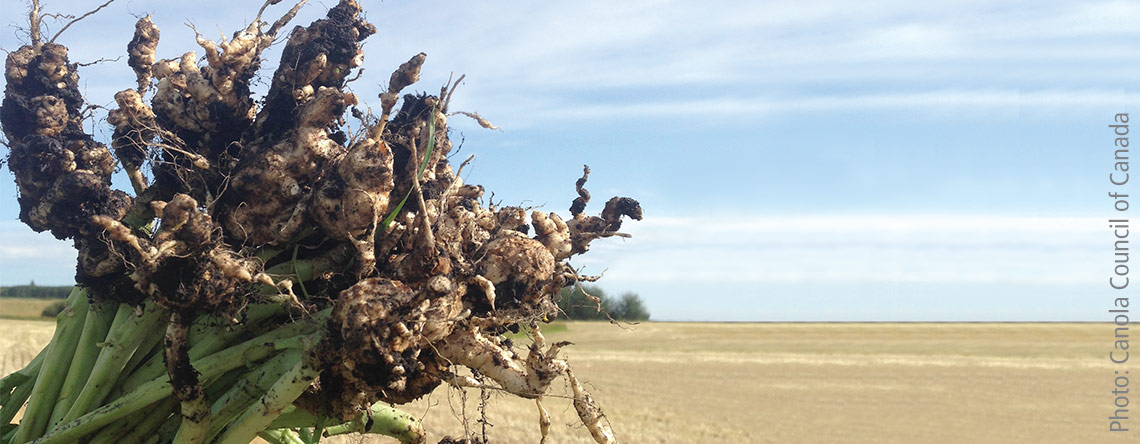Clubroot is difficult to manage once established in canola, making prevention critical.
How does the old saying go? “Where there are brassicas, there is clubroot.” Maybe not quite, but the sentiment is appropriate.
A widespread problem for the global agriculture industry, Plasmodiophora brassicae, commonly known as clubroot, is a soil-borne disease of all brassica crops, including canola, which causes swollen galls resembling clubs on plant roots. These galls restrict the flow of water and nutrients, causing premature death of the plant.
There are many different pathotypes of clubroot, and each individual gall can produce millions, or even billions, of disease spores which can survive in soil during the winter. In the spring, these spores germinate and become mobile.
Then, they can move freely through soil, infect plant root hairs and eventually release a second generation of disease spores into the soil.
In Canada, clubroot spore counts have been rising in canola acres since 2003, especially around the Edmonton area in Alberta. The disease is also gaining a foothold in canola fields across Saskatchewan, Manitoba and Ontario.
Once introduced into a field, disease spores can survive in the soil for up to 20 years, making proactive disease prevention critical.
Expert Advice
In both Western Canada and Ontario, ag retailers can play an important role in working with canola growers to help keep the disease out of their soil for as long as possible and to manage clubroot, if it does become established.
Best practices for disease prevention include: crop scouting, crop rotations, equipment sanitation, limiting tillage and the sustainable use of clubroot resistant (CR) varieties.
“It’s critical to help growers do everything they can to keep the disease off their fields for as long as possible,” says Rene Mabon, agronomic services manager with BrettYoung Seeds. “A knowledgeable agronomist can bring forward a number of strategies to help growers prevent the onset of this disease.”
Mabon says agronomists should help their growers put together a clubroot management strategy and says the first steps in that strategy are crop scouting and soil testing.
Clubroot primarily spreads to new fields through soil movement, with spores carried by the movement of soil on equipment. If growers have low, undetected spore populations in their soil, there’s a risk of inadvertently spreading the disease if they aren’t taking the right precautions.
“Unless you’re regularly scouting and sending away soil samples to test for clubroot, then you just don’t necessarily know whether you have it or not,” says Mabon.
Scouting and Sanitization
Jakob Kruse works as a sales agronomist with Ray Agro & Petroleum Ltd. (Ray Agro) in Stony Plain, Alta., just west of Edmonton. Stony Plain sits in Parkland County, where more than 50 fields tested positive for the disease in Alberta Agriculture and Forestry’s latest clubroot survey.
Kruse says none of the growers he works with currently have clubroot, but with such a strong presence of the disease in Alberta and the Edmonton area, his customers are well aware of it and are doing everything they can to keep clubroot out of their soil.
“I start scouting for clubroot fairly early, right from the seedling stage,” says Kruse. “Clubroot isn’t too widespread around here yet, so it’s very important to keep an eye out for those early warning signs.”
When he scouts early on, Kruse is looking for anything that looks like moisture stress, which clubroot can often be mistaken for, wilting of the crop or stunted crop growth. As the season progresses, he begins pulling up plants to check for the tell-tale clubbed roots.
Kruse scouts the entire field but pays particular attention to the field entrance. This is where initial patches of clubroot tend to show up first, due to equipment entering and exiting the field.
When it comes to equipment, Kruse says his growers do everything they can in terms of sanitization, but it’s a challenge to completely sanitize large equipment – growers simply lack the time and the labour.
“No grower is going to fully clean all of their equipment down to a tiny dust kernel before they leave a field,” he says. “But, the growers I work with try to do as much as possible to clean soil off their equipment before they move to the next field.”
Seeding Resistance
Sanitization and scouting can be time consuming but are both very important for managing the spread of the disease. Equally important and effective in the fight against clubroot is to plant clubroot resistant (CR) canola varieties.

“The big thing around clubroot and having it not become a problem in your field or your geography is keeping the sporeload to a minimum,” says Eric Gregory, canola product manager with BrettYoung Seeds.
“There’s a certain number of spores that are required before you start seeing symptoms of the disease,” Gregory continues. “If growers are concerned about clubroot in their area, growing a resistant variety is a best practice. That way, you’re not contributing additional sporeload through the crop you’re growing without knowing it.”
Kruse says that all but one of his customers are growing CR canola varieties this season. “We had one grower this year who had never planted any canola on those fields before. In that case, it’s pretty safe to grow a susceptible variety, but for everybody else, they’re growing resistant varieties in this area,” he says.
When it comes to selecting the right CR variety, Gregory recommends those with a broad base of resistance.
The big thing around clubroot and having it not become a problem in your field or your geography is keeping the sporeload to a minimum.
“The best strategy is to choose varieties that show different resistance profiles, meaning they’re resistant to multiple pathotypes,” he says. “Growing a resistant variety with a broad profile is one way you can be proactive and hopefully delay the onset of the disease for as many years as possible.”
When recommending CR varieties, Mabon says it’s important to remind growers that they must be used sustainably to keep the resistant genes effective.
“Pushing tight rotations with resistant varieties increases the risk of clubroot pathotypes adapting to overcome those resistance genes,” he explains.
“What was originally a small number of pathotypes has now grown into a more diverse pathotype population,” he continues. “That unfortunately came about from growers using the initial sources of resistance on short rotations. You definitely don’t want to push your rotations too tight.”
What was originally a small number of pathotypes has now grown into a more diverse pathotype population. That unfortunately came about from growers using the initial sources of resistance on short rotations.
Studies suggest that a minimum two-year break from canola on fields that have clubroot will help protect the integrity of the resistant genes. New research presented at the International Clubroot Workshop held in Edmonton this August suggests that a three-year break between canola crops in heavily infested fields may be the magic number, with longer rotations not showing substantial improvements in spore reductions over a three-year break.
Kruse says the majority of his customers are using rotations of at least two years to maintain the efficacy of their CR varieties. A few of his customers with smaller operations have been tempted to push canola tighter if they struggle to find a buyer for other crops, but he says he is more than willing to help them find buyers, another action retailers can take to encourage healthy rotations.
“I am willing to work with growers to figure out a buyer, and in my experience, growers are open to adding another crop into the rotation,” says Kruse.
The Ontario Experience
 Moving east, clubroot is becoming a virulent pest to watch for in Ontario canola acres. According to Meghan Moran, field crop canola and edible bean specialist with the Ontario Ministry of Agriculture, Food and Rural Affairs (OMAFRA), clubroot was first discovered in Ontario canola in 2016, and has found its way into virtually all canola growing regions in the province.
Moving east, clubroot is becoming a virulent pest to watch for in Ontario canola acres. According to Meghan Moran, field crop canola and edible bean specialist with the Ontario Ministry of Agriculture, Food and Rural Affairs (OMAFRA), clubroot was first discovered in Ontario canola in 2016, and has found its way into virtually all canola growing regions in the province.
Moran worked on OMAFRA’s first clubroot survey, conducted during the 2016 growing season, the results of which were released in 2017.
“When we surveyed all canola growing regions in the province, we found clubroot in most of them. It can be a surprise for our growers when they find it on their farm but, knowing the nature of that disease, it does make sense,” says Moran.
According to Moran, Ontario growers face a few unique challenges when it comes to preventing and managing the disease, compared to their Western Canadian counterparts. One such challenge is that clubroot may not present the same way in Ontario canola as it does in Western Canadian canola, due to environmental differences between the regions.
Although clubroot has actually been established in Ontario for several decades, Moran says it was limited to other brassica crops grown in Ontario, like broccoli, cabbage and cauliflower.
“I wouldn’t say there’s really any crossover between those vegetable growers and our canola growers,” says Moran. “Even though it’s been in the province for a long time, our canola growers are only familiar with clubroot through the Western Canadian experience and don’t have any reference for managing it based on local conditions.”
Moran says that because Ontario soils generally have higher moisture levels than western soils, they tend to conduct more tillage in the province.
“Though I’ve never seen it myself, apparently in the west you find clubroot near the field entrances and you can try to mitigate its spread by addressing those areas,” she says. “They have some interesting ideas about preventing clubroot from spreading through a field by managing that field entrance.”
Moran says if Ontario growers are going by western advice, they may think they’re home free if their field entrances are clear of clubroot, when really, they’re not scouting as thoroughly as they need to.
“With the amount of tillage we conduct, we’re probably moving it all around the field before we even know we have it,” she says. “So, I don’t know that clubroot will necessarily present the same way here as it does out west. You’re not going to see it limited only to the field entrance in that initial presentation.”
To help their growers manage clubroot, Moran recommends Ontario retailers thoroughly scout and soil test all areas of the field, not just entrances, and inform their customers about the differences between what they’re hearing about clubroot from Western Canada, versus what is really going on in their fields.
Another challenge Moran says growers can face is limited access to resistant varieties of canola.
“We have a very small acreage of canola in Ontario compared to Western Canada, which means there aren’t as many seed varieties available for canola growers in Ontario,” she says. With fewer varieties overall, there are also fewer CR varieties for growers to choose from.
Even with limited options, Moran says it is still very much worthwhile for growers to switch from growing susceptible varieties to growing CR varieties.
“Generally speaking, the only growers who are using resistant varieties are the growers who know they have clubroot,” she says. “If a grower knows there are cases of clubroot in their region, it would be beneficial for them to start planting those resistant varieties, but I just don’t think that’s happening.”
Advice Across the Country
Whether it’s in Ontario or Western Canada, retailers play a crucial role in helping growers prevent and manage clubroot. By talking with their customers about the disease and encouraging them to make the most of the management options available to them, retailers can help keep canola fields healthy and viable for years to come.
“There are a lot of agronomists out there who are very much on top of this disease,” says Gregory. “The best way to handle these situations is documenting a management plan and getting growers to follow best practices based on those agronomic recommendations to reduce sporeload in the field.”
Gregory also encourages retailers to stay on top of the latest clubroot research, noting that what the academic community understands about clubroot is changing from year-to-year and calling it a “moving target.” But, by keeping up with the latest developments, retailers can continue to provide valuable information for their customers.
“Educate, educate, educate,” says Kruse. “Beyond giving customers the main management points, educate them on the seriousness of the disease. Try to put it in the farmer’s head that it’s out there. Even if symptoms aren’t showing in their field, the danger is there.”
Related Articles
- AI & Ag A viewpoint on how artificial intelligence can positively impact the agricultural sector. By Andrew Joseph, Editor When it comes to AI, aka artificial intelligence, people either know all about it or they don’t. ...
- Myrna Grahn is our new Executive Director We are excited to announce the appointment of Myrna Grahn as the new Executive Director of the Canadian Association of Agri-Retailers (CAAR). She stepped into her new role as of March 25, 2024. Myrna brings a wea...
- Strategies to recruit top talent Craft tailored compensation packages, offer flexible work arrangements, and create an optimum work environment. By Denise Faguy, Associate Editor Data from the Canadian Agricultural Human Resource Council (CAHRC)...
- Show your mature workforce the love they deserve Learn how the top employers support the ever-evolving needs of their employees through their changing career phases. By Denise Faguy, Associate Editor If there’s one thing all within CAAR can agree upon, is that ...
- Views, Considerations & Unknowns for 2024 With 2024 upon us, the agriculture trade show and seminar season is now in full swing. By Mitch Rezansoff, Executive Director With 2024 upon us, the agriculture trade show and seminar season is now in full swing....
 How to resolve AdBlock issue?
How to resolve AdBlock issue? 

Join the discussion...
You must be logged in as a CAAR member to comment.
Report
My comments